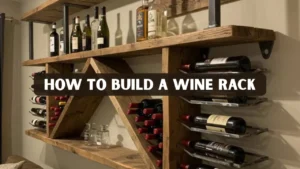Building a violin is one of the most rewarding woodworking projects you can take on, especially if you’ve ever wondered how to build a violin from scratch. It tests your patience, attention to detail, and craftsmanship, as each curve and joint affects the sound and playability of the instrument. The process blends art and engineering, requiring precise shaping, carving, and assembly to achieve a perfect balance of tone and structure.
Key Takeaways
- Learn the essential tools and materials needed for violin construction
- Understand each stage of the carving, assembly, and finishing process
- Discover common mistakes and how to avoid them
- Get practical advice to enhance precision and sound quality
- Gain the confidence to craft your first violin successfully
Why Build a Violin
Learning how to build a violin offers far more than a finished instrument. It deepens your understanding of sound, craftsmanship, and material behavior.
- Skill Development: Violin making teaches advanced woodworking, precision carving, and fine finishing. It helps you refine your craftsmanship and gain a deeper understanding of how wood responds to tools and sound.
- Personal Satisfaction: Building something playable from raw wood is incredibly fulfilling. Watching your instrument come to life through your own effort gives a sense of accomplishment unmatched by store-bought instruments.
- Customization: You can choose tonewoods, finishes, and designs to match your artistic vision. This freedom allows you to create a violin that truly reflects your personal style and musical preferences.
- Cost Efficiency: For hobbyists, making your own violin can be more economical than buying a handcrafted one. It also lets you control material quality and craftsmanship without paying premium retail prices.
- Cultural Appreciation: Understanding traditional violin-making techniques connects you with centuries of musical artistry. It preserves the heritage of classical craftsmanship and deepens your respect for historical luthiers.
Building a violin also cultivates patience, discipline, and respect for craftsmanship values that define every successful woodworker.
Tools and Materials Needed
Materials
- Spruce for the top plate
- Maple for back, ribs, and neck
- Ebony for fingerboard, pegs, and tailpiece
- High-quality hide glue or wood glue
- Varnish or lacquer for finishing
- Strings, bridge, and end button
- Templates for shape accuracy
- Clamps and corner blocks for rib assembly
Tools
- Lathe for turning pegs and scrolls
- Chisels, gouges, and carving knives
- Coping saw for plate cutting
- Bending iron for shaping ribs
- Sandpaper (various grits)
- Calipers and ruler for thickness measurement
- A stable, well-lit workbench
- Dust mask, gloves, and safety glasses
Pro Tip: Beginners can start with a violin kit that provides pre-cut components for easier assembly.
Preparing Your Workspace
Preparation sets the tone for precision work.
Step by Step Guide
Step 1: Crafting the Violin Body
The body shapes the tone of your instrument.
-
Trace and Cut Plates
-
Outline the top (spruce) and back (maple) plates using templates. Templates ensure consistent curves and dimensions, giving your violin a balanced and symmetrical shape.
-
-
-
Carve and Hollow Plates
-
Carve the outer arching with gouges. Shape the smooth, curved surface that defines the violin’s tone and resonance, working slowly to follow natural grain lines.
-
Hollow the inside gradually to achieve ideal thickness. Remove wood layer by layer to balance strength and vibration, enhancing the instrument’s sound quality.
-
-
-
Shape and Assemble Ribs
-
Thin maple strips are bent using a heated bending iron. Apply gentle pressure and steady heat to shape the strips smoothly without cracking or scorching the wood.
-
Glue ribs to corner blocks and linings for support. Use high-quality hide glue for strong joints that can be easily adjusted during assembly if needed.
-
-
-
Join the Plates and Ribs
- Glue the top plate to the ribs, then add the back plate. Apply even glue for a clean, secure fit.
-
Use clamps evenly for consistent pressure. This keeps the plates aligned and prevents gaps while drying.
Step 2: Carving the Neck and Scroll
The neck affects playability, and the scroll adds artistry.
- Cut the neck blank from maple. Start with a precise piece for stability and strength.
- Use gouges to carve the scroll’s spiral shape. Carve slowly for smooth curves and detailed craftsmanship.
- Shape the pegbox carefully for smooth tuning peg insertion. Ensure pegs fit snugly without binding.
- Ensure perfect neck alignment before attaching it to the body. Proper alignment affects playability and string balance.
Step 3: Installing Fingerboard, Pegs, and Tailpiece
Step 4: Finishing and Assembly
- Sand the entire surface with progressively finer grits for smoothness. This prepares the wood for an even finish.
- Apply thin coats of varnish or lacquer to protect the wood and enhance beauty. Multiple layers improve durability and shine.
- Let each coat dry completely before applying the next. Proper drying prevents smudges and uneven texture.
- Install strings, fine tuners, and adjust the bridge position. Ensure correct tension and alignment for optimal sound.
- Conduct fine tuning for playability. Check each string and adjust for balanced tone and smooth play.
Common Mistakes to Avoid
- Uneven plate thickness reducing sound quality. Check thickness regularly to maintain consistent tone.
- Misaligned neck or bridge. Proper alignment is essential for playability and string balance.
- Using excessive glue or insufficient clamping pressure. Apply the right amount and distribute clamps evenly.
- Rushing varnish application. Take time to apply thin, even coats for a smooth finish.
- Neglecting wood humidity control. Keep wood at stable humidity to prevent warping or cracking.
Tips for Hobby Woodworkers
- Practice on scrap wood before carving the violin plates. This helps you master techniques without risking the main pieces and builds confidence in how to build a violin.
- Use precision tools and measure frequently. Accurate measurements ensure symmetry and proper fit.
- Take detailed notes of measurements and angles for future reference. Documentation helps replicate or adjust designs later.
- Allow glue and varnish ample drying time. Proper curing prevents weak joints and uneven finishes.
- Work patiently, perfection takes time. Rushing can lead to mistakes that affect sound and appearance.
Case Studies
- Mark Thompson, a hobbyist from Oregon, built his first violin from spruce and maple using a small home workshop. His dedication taught him valuable lessons in carving symmetry and plate thickness control, resulting in a surprisingly playable instrument.
- Sarah Lin, an art student in New York, built a decorative violin using a beginner kit. Through careful varnishing and scroll carving, she turned her classroom project into a museum-quality display piece that earned her top honors in a design competition.
These real-world examples show that learning how to build a violin is achievable for anyone with patience and the right tools.
Conclusion
Building a violin is a test of craftsmanship, creativity, and patience. From carving the plates and assembling the ribs to varnishing and tuning, every step requires attention and care. This detailed guide has shown you how to build a violin from start to finish while sharing expert insights and real-world success stories.
Creating your own violin not only enhances your woodworking skills but also gives you a sense of pride in producing something truly timeless. Take your time, follow each stage carefully, and enjoy the beauty of transforming raw wood into music.
FAQs
How long does it take to build a violin?
It typically takes 40 to 100 hours, depending on your skill level and complexity of the design. Beginners may spend more time perfecting alignment and finishing.
Can a beginner really build a playable violin?
Yes. Many beginners start with kits that simplify cutting and shaping while still offering full assembly and finishing practice.
What wood gives the best tone?
Spruce for the soundboard and maple for the back and sides provide balance, resonance, and durability.
Is using a lathe necessary?
Not mandatory, but it improves precision when crafting scrolls, pegs, and decorative details.
How do I finish my violin?
Use a high-quality varnish in multiple thin layers. Allow each coat to dry thoroughly and polish gently for a glossy, professional finish.




